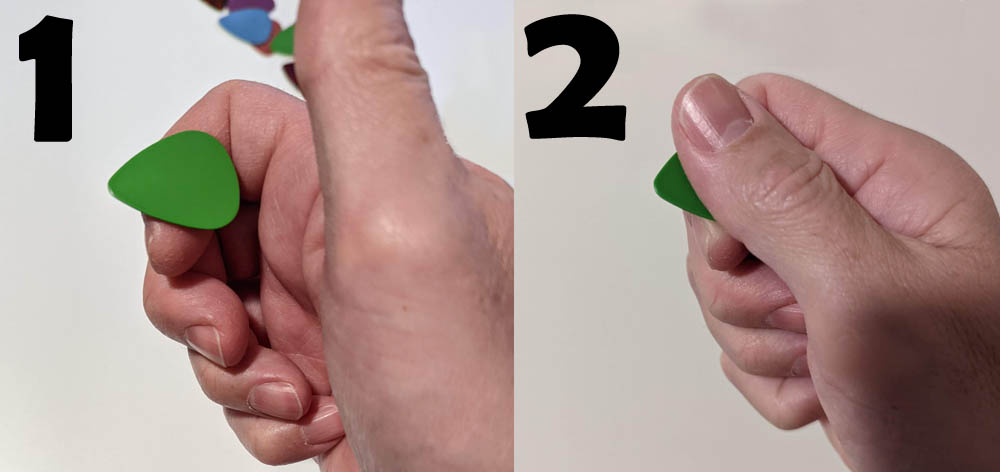How To Strum With A Pick Smoothly (Easy Guitar Tips)
Learning how to strum smoothly with a pick takes some practice. You have to become used to the plectrum that essentially becomes an extension of your fingertips.
It can be a frustrating struggle when you first start, but with some time and practice it soon gets easier, until strumming with a pick feels completely natural..
The key to strumming smoothly with a pick lies in the type of pick you use, the angle you hold your pick, and how firmly you hold your pick. By holding your pick correctly and practicing strumming patterns regularly, you’ll learn the art of strumming smoothly in no time.
Many starting guitarists tend to grab the first pick they see, or the one they think is the coolest in style, but choosing the right pick is an important part of developing good habits and becoming a better guitarist.

Types Of Picks
You’ll find picks come in a variety of shapes and sizes, as well as gauges, and each is designed with a specific goal in mind. Technically, it’s good practice to have at least three different picks: one for strumming, one for picking chords, and one for riffs and solos.
For the purposes of this discussion, we’ll limit the topic to the Standard 351 guitar pick that has a wider body and rounded tip, which is best for strumming.
The 351 picks come in ultra-thin, thin, medium, heavy, and extra heavy. The thickness of the pick will determine how much it flexes as you strum.

More flexible picks are easier to strum with, but they offer less control. While thicker picks offer better control, they won’t flex very much across your strings.
Purpose Of Picks
Not every guitarist uses picks, and that’s okay. There’s no hard and fast rule that says you have to. Some guitarists argue that picks detract from speed. Some just prefer the warm, soft sound of pickless strumming. It really depends on your play style.
The general purpose of picks is to increase your volume, control, and versatility. This is especially important if you’re playing in a group with other musical instruments.
It doesn’t take much to bury the sound of a guitar so increasing and controlling your volume becomes important.
Thinner Picks Help Beginners Strum Smoothly
A multitude of guitar instructors teach beginning guitarists that, “Slow is steady, steady is smooth, and smooth is fast.” Thinner picks help beginning guitarists develop a slow, steady, smooth strum.
Picks work by displacing guitar strings causing them to vibrate. Because thin picks have more give, they actually displace a tad bit more than the strings themselves, allowing you to develop a fluid motion with your hands and arm.
Thin picks are much more forgiving making errors less noticeable, which also makes them better for beginners. Plus, they’re pliability makes them easier to grip and prevent sliding.
Their flexibility allows them to stroke across the strings smoothly without hanging up. A thinner pick also offers a slight percussive sound, similar to a washboard, helping you hear the rhythm of the guitar.
It really helps you feel the beat of the rhythm, which is, of course, what strumming is all about.
The downside to thin picks is that they aren’t very durable, especially if you are an aggressive strummer. They have a tendency to splinter and crack over time, so make sure you have plenty of them.
How To Hold Your Pick For Smooth Strumming
The best way to hold your pick for smooth strumming is to ensure that your wrist stays loose and the pick is between your thumb and forefinger.
Follow these steps:
- Start by making a thumbs up with your hand.
- Rest your pick on top of your index finger at the first digit with the point facing towards you.
- Make sure it’s resting on the side of your finger, not the face.
- Place your thumb on top of the pick.
- Make sure you leave a decent amount of the pick exposed. This will vary based on what you’re playing.

Alternatively, you can make an okay sign, then slip the pick in between your thumb and forefinger. Again, ensure it’s resting on the side of your finger.
There’s a fine line between too much pick and not enough pick. For strumming, a good third to half of your pick should be exposed outside of your grip.
The Best Pick Angle For Strumming
The general consensus is to hold your pick between 10 and 30 degrees. This allows you to smoothly transition to each string ensuring that you’re striking each one.
Your pick should be angled in the opposite direction of your strum. If you are strumming downward your pick should be angled up and vice versa.
How Tight Should You Hold Your Pick?
You should hold your pick just tight enough that you’re not letting go. It shouldn’t slip around, but it’s not uncommon to lose your pick a lot when you’re first starting out. It’s part of the learning process.
It should be loose enough that your strum feels smooth and natural. The stronger the grip, the harder it is to flow naturally. A firm pencil grip ought to do it.
Simple Strum Patterns Help To Learn Smooth Strumming
Learning how to strum properly is one of the best things you can do as a guitarist. Just a few strumming patterns can turn you into a solid versatile player.
Rhythm is the most important part of any song, and that’s exactly what strumming provides. Here are three simple strumming patterns to start with.
1) Basic four-beat pattern
One of the simplest patterns that most new guitarists start with is a basic four-beat down strum.
When denoting strums on paper, slash marks are typically used to represent the down stroke (/) while an up arrow (^) is used to represent the up-stroke. Sometimes you’ll see ‘D’ for down and ‘U’ for up.
So a four-beat down strum may look like / / / / or D D D D.
When you count it out, it looks like this:

It’s slow and boring, but it’s where most of us start. It’s also essential for learning the basics of keeping rhythm, especially if you have no musical experience.
Remember, slow is steady, steady is smooth, smooth is fast.
Once you feel comfortable keeping time with a basic four-beat count, you can upgrade to a simple pattern that’s played in a whole lot of songs.
2) Basic Rock Pattern
Although it’s called a rock pattern, it’s by no means limited to rock. It can be used in any kind of genre and is equally popular in pop and country songs.
Once you’ve learned this pattern, all you need are the chords to your favorite songs. You’ll be playing along before you know it.
The pattern uses a combination of quarter notes and eighth notes, which when you count out sounds like “one and two and three and four and.”
The strumming pattern uses “down, down, up, up, down, up,” but where you place the strums is crucial to the rhythm.
So it looks like this:

It takes some practice.
It’s sort of like patting your head and rubbing your belly. At first, it feels very uncoordinated, but the more you practice the easier it becomes.
If you think in terms of strumming down on all the numbers and strumming up on the word ‘and,’ it may be easier to digest.
3) Southern Rock
A modified version of the basic rock pattern makes this pattern super easy because it’s just a slight variation. The only difference between this pattern and the one above is that you remove the up-stroke on the fourth ‘and,’ so it looks like this:

This strum gives a nice, steady shuffle to some of your favorite songs of all time.
Start With Slow Strumming And Build Up Your Speed
Slow is steady, steady is smooth, smooth is fast.
Start slow, focusing on your technique. Ensure you’re holding your pick correctly. It takes time to learn how to hold a musical cadence in your head while multitasking with the strum of your hand.
Once you’ve gotten your rhythm count in line with your hand strum, then you can start working on speed. Keep your pace steady and rhythmic. Once you’ve developed a smooth, natural strum, then you can start working on your speed.
Final Thoughts
Learning to strum with a pick can be an awkward task that takes sufficient practice to master. Following a few simple techniques in conjunction with the right pick and regular practice will have you strumming your favorite songs in no time.




